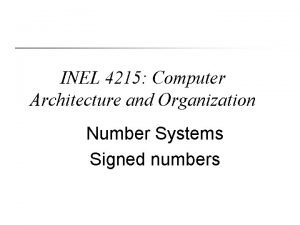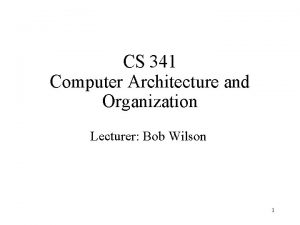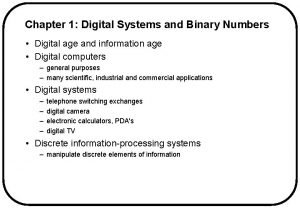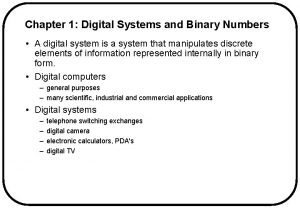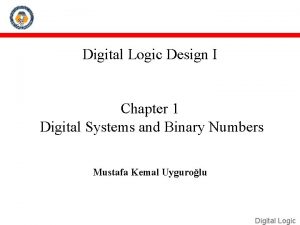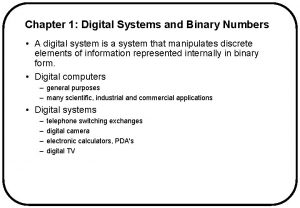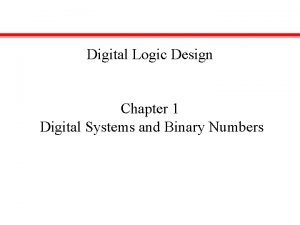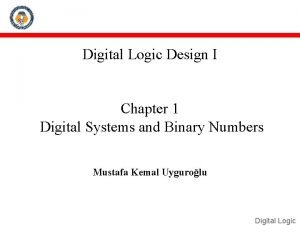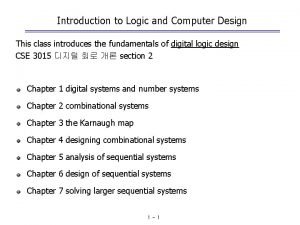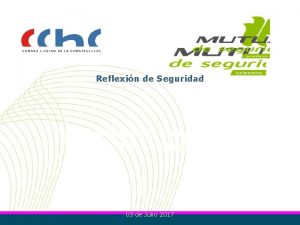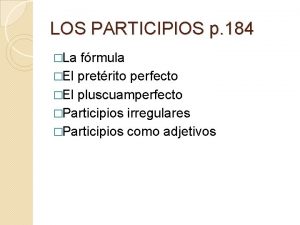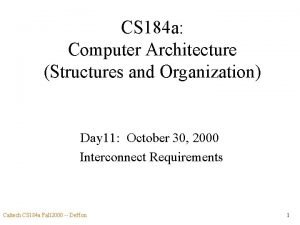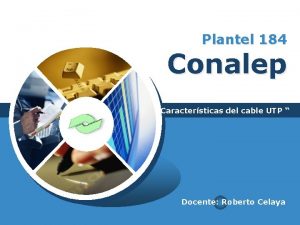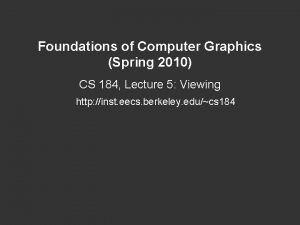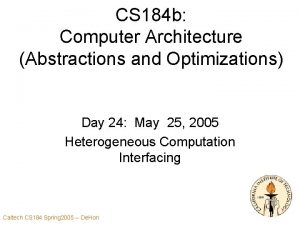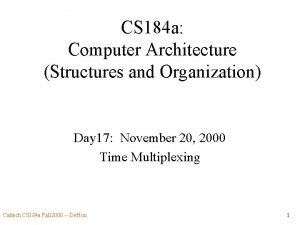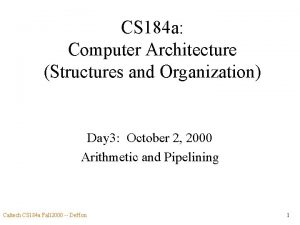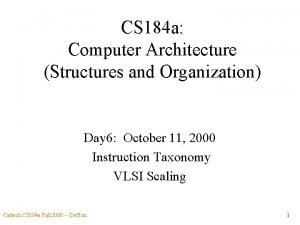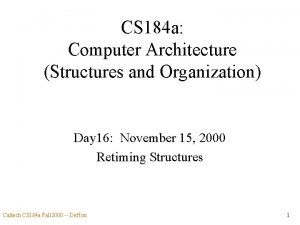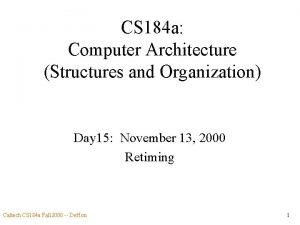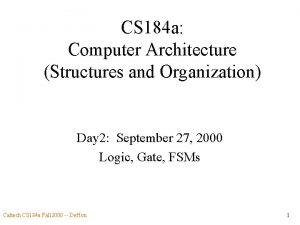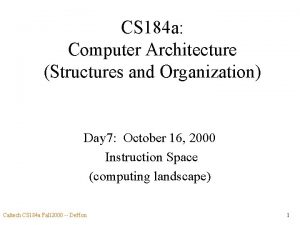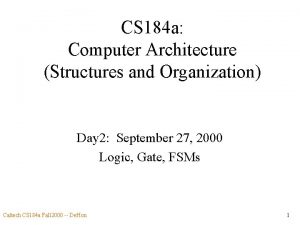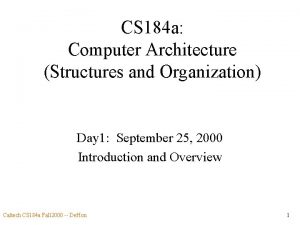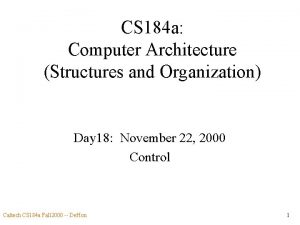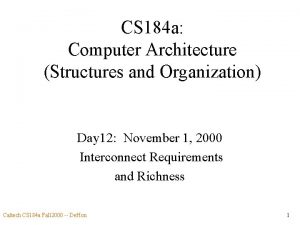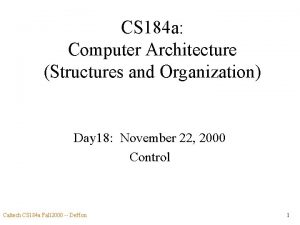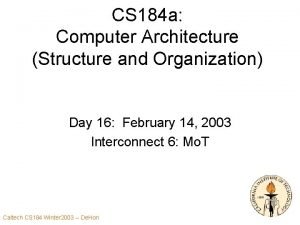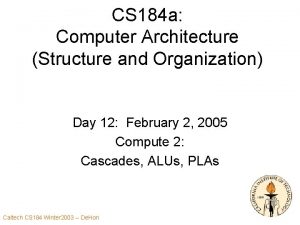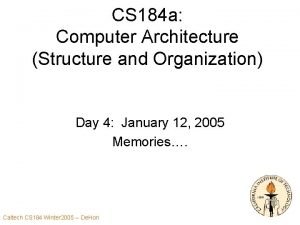CS 184 a Computer Architecture Structures and Organization










































![Big Ideas [MSB Ideas] • Memory most dense programmable structure for the most complex Big Ideas [MSB Ideas] • Memory most dense programmable structure for the most complex](https://slidetodoc.com/presentation_image_h2/63ef0338ab31a838a20ec5f6bc4abc7e/image-43.jpg)
![Big Ideas [MSB-1 Ideas] • Area – LUT count decrease w/ K, but slower Big Ideas [MSB-1 Ideas] • Area – LUT count decrease w/ K, but slower](https://slidetodoc.com/presentation_image_h2/63ef0338ab31a838a20ec5f6bc4abc7e/image-44.jpg)
![Big Ideas [MSB-1 Ideas] • Delay – LUT depth decreases with K • in Big Ideas [MSB-1 Ideas] • Delay – LUT depth decreases with K • in](https://slidetodoc.com/presentation_image_h2/63ef0338ab31a838a20ec5f6bc4abc7e/image-45.jpg)
- Slides: 45

CS 184 a: Computer Architecture (Structures and Organization) Day 8: October 18, 2000 Computing Elements 1: LUTs Caltech CS 184 a Fall 2000 -- De. Hon 1

Last Time • Instruction Space Modeling – huge range of densities – huge range of efficiencies – large architecture space – modeling to understand design space • Started on Empirical Comparisons – [not sure when we’ll finish this up] Caltech CS 184 a Fall 2000 -- De. Hon 2

Today • Look at Programmable Compute Blocks • Specifically LUTs Today • Recurring theme: – define parameterized space – identify costs and benefits – look at typical application requirements – compose results, try to find best point Caltech CS 184 a Fall 2000 -- De. Hon 3

Compute Function • What do we use for “compute” function • Any Universal – NANDx – ALU – LUT Caltech CS 184 a Fall 2000 -- De. Hon 4

Lookup Table • Load bits into table – 2 N bits to describe – => 22 N different functions • Table translation – performs logic transform Caltech CS 184 a Fall 2000 -- De. Hon 5

Lookup Table Caltech CS 184 a Fall 2000 -- De. Hon 6

We could. . . • Just build a large memory = large LUT • Put our function in there • What’s wrong with that? Caltech CS 184 a Fall 2000 -- De. Hon 7

FPGA = Many small LUTs Alternative to one big LUT Caltech CS 184 a Fall 2000 -- De. Hon 8

Toronto FPGA Model Caltech CS 184 a Fall 2000 -- De. Hon 9

What’s best to use? • Small LUTs • Large Memories • …small LUTs or large LUTs • …or, how big should our memory blocks used to peform computation be? Caltech CS 184 a Fall 2000 -- De. Hon 10

Start to Sort Out: Big vs. Small Luts • Establish equivalence – how many small LUTs equal one big LUT? Caltech CS 184 a Fall 2000 -- De. Hon 11

“gates” in 2 -LUT ? Caltech CS 184 a Fall 2000 -- De. Hon 12

How Much Logic in a LUT? • Lower Bound? – Concrete: 4 -LUTs to implement M-LUT • Not use all inputs? – 0 … maybe 1 • Use all inputs? – (M-1)/3 • example M-input AND • cover 4 ins w/ first 4 -LUT, • 3 more and cascade input with each additional – (M-1)/k for K-lut Caltech CS 184 a Fall 2000 -- De. Hon 13

How much logic in a LUT? • Upper Bound: – M-LUT implemented w/ 4 -LUTs – M-LUT 2 M-4+(2 M-4 -1) 2 M-3 4 -LUTs Caltech CS 184 a Fall 2000 -- De. Hon 14

How Much? • Lower Upper Bound: M 2 2 functions – realizable by M-LUT – Say Need n 4 -LUTs to cover; compute n: • strategy count functions realizable by each 4 n 2 (2 ) M 2 2 • 4 M 2 2 • nlog(2 ) • n 24 log(2) 2 Mlog(2) • n 24 2 M • n 2 M-4 Caltech CS 184 a Fall 2000 -- De. Hon 15

How Much? • Combine – Lower Upper Bound – Upper Lower Bound – (number of 4 -LUTs in M-LUT) 2 M-4 n 2 M-3 Caltech CS 184 a Fall 2000 -- De. Hon 16

Memories and 4 -LUTs • For the most complex functions an M-LUT has ~2 M-4 4 -LUTs • SRAM 32 Kx 8 l=0. 6 mm – 170 Ml 2 (21 ns latency) – 8*211 =16 K 4 -LUTs • XC 3042 l=0. 6 mm – 180 Ml 2 (13 ns delay per CLB) – 288 4 -LUTs • Memory is 50+x denser than FPGA – …and faster Caltech CS 184 a Fall 2000 -- De. Hon 17

Memory and 4 -LUTs • For “regular” functions? • 15 -bit parity – entire 32 Kx 8 SRAM – 5 4 -LUTs • (2% of XC 3042 ~ 3. 2 Ml 2~1/50 th Memory) • 7 b Add – entire 32 Kx 8 SRAM – 14 4 -LUTs • (5% of XC 3042, 8. 8 Ml 2~1/20 th Memory) Caltech CS 184 a Fall 2000 -- De. Hon 18

LUT + Interconnect • Interconnect allows us to exploit structure in computation • Already know – LUT Area << Interconnect Area – Area of an M-LUT on FPGA >> M-LUT Area • …but most M-input functions – complexity << 2 M Caltech CS 184 a Fall 2000 -- De. Hon 19

Different Instance, Same Concept • Most general functions are huge • Applications exhibit structure • Exploit structure to optimize “common” case Caltech CS 184 a Fall 2000 -- De. Hon 20

LUT Count vs. base LUT size Caltech CS 184 a Fall 2000 -- De. Hon 21

LUT vs. K • DES MCNC Benchmark – moderately irregular Caltech CS 184 a Fall 2000 -- De. Hon 22

Toronto Experiments • Want to determine best K for LUTs • Bigger LUTs – handle complicated functions efficiently – less interconnect overhead • Smaller LUTs – handle regular functions efficiently – interconnect allows exploitation of compute sturcture • What’s the typical complexity/structure? Caltech CS 184 a Fall 2000 -- De. Hon 23

Familiar Systematization • Define a design/optimization space – pick key parameters – e. g. K = number of LUT inputs • Build a cost model • Map designs look at resource costs at each point • Compose: Logical Resources Resource Cost • Look for best design points Caltech CS 184 a Fall 2000 -- De. Hon 24

Toronto LUT Size • Map to K-LUT – use Chortle • Route to determine wiring tracks – global route – different channel width W for each benchmark • Area Model for K and W Caltech CS 184 a Fall 2000 -- De. Hon 25

LUT Area vs. K • Routing Area roughly linear in K Caltech CS 184 a Fall 2000 -- De. Hon 26

Mapped LUT Area • Compose Mapped LUTs and Area Model Caltech CS 184 a Fall 2000 -- De. Hon 27

Mapped Area vs. LUT K N. B. unusual case minimum area at K=3 Caltech CS 184 a Fall 2000 -- De. Hon 28

Toronto Result • Minimum LUT Area – at K=4 – Important to note minimum on previous slides based on particular cost model – robust for different switch sizes • (wire widths) • [see graphs in paper] Caltech CS 184 a Fall 2000 -- De. Hon 29

Implications Caltech CS 184 a Fall 2000 -- De. Hon 30

Implications • Custom? / Gate Arrays? • More restricted logic functions? Caltech CS 184 a Fall 2000 -- De. Hon 31

Relate to Sequential? • How does this result relate to sequential execution case? • Number of LUTs = Number of Cycles • Interconnect Cost? – Naïve – structure in practice? • Instruction Cost? Caltech CS 184 a Fall 2000 -- De. Hon 32

Delay Back to Spatial (save for day 10). . . Caltech CS 184 a Fall 2000 -- De. Hon 33

Delay? • Circuit Depth in LUTs? • “Simple Function” --> M-input AND – 1 table lookup in M-LUT – logk(M) in K-LUT Caltech CS 184 a Fall 2000 -- De. Hon 34

Delay? • M-input “Complex” function – 1 table lookup for M-LUT – between: (M-K)/log 2(k) +1 – and (M-K)/log 2(k- log 2(k)) +1 Caltech CS 184 a Fall 2000 -- De. Hon 35

Delay • Simple: log M • Complex: linear in M • Both go as 1/log(k) Caltech CS 184 a Fall 2000 -- De. Hon 36

Circuit Depth vs. K Caltech CS 184 a Fall 2000 -- De. Hon 37

LUT Delay vs. K • For small LUTs: – t. LUT c 0+c 1 K • Large LUTs: – add length term – c 2 2 K • Plus Wire Delay – ~ area Caltech CS 184 a Fall 2000 -- De. Hon 38

Delay vs. K Why not satisfied with this model? Delay = Depth (t. LUT+ t. Interconnect) Caltech CS 184 a Fall 2000 -- De. Hon 39

Observation • General interconnect is expensive • “Larger” logic blocks – => less interconnect crossing – => lower interconnect delay – => get larger – => get slower • faster than modeled here due to area – => less area efficient • don’t match structure in computation Caltech CS 184 a Fall 2000 -- De. Hon 40

Finishing Up. . . Caltech CS 184 a Fall 2000 -- De. Hon 41

No Class Monday CS Dept. Retreat Sun/Mon. André not read email on Sunday. Catchup on reading, assignment, sleep… see you Wednesday. Caltech CS 184 a Fall 2000 -- De. Hon 42
![Big Ideas MSB Ideas Memory most dense programmable structure for the most complex Big Ideas [MSB Ideas] • Memory most dense programmable structure for the most complex](https://slidetodoc.com/presentation_image_h2/63ef0338ab31a838a20ec5f6bc4abc7e/image-43.jpg)
Big Ideas [MSB Ideas] • Memory most dense programmable structure for the most complex functions • Memory inefficient (scales poorly) for structured compute tasks • Most tasks have some structure • Programmable Interconnect allows us to exploit that structure Caltech CS 184 a Fall 2000 -- De. Hon 43
![Big Ideas MSB1 Ideas Area LUT count decrease w K but slower Big Ideas [MSB-1 Ideas] • Area – LUT count decrease w/ K, but slower](https://slidetodoc.com/presentation_image_h2/63ef0338ab31a838a20ec5f6bc4abc7e/image-44.jpg)
Big Ideas [MSB-1 Ideas] • Area – LUT count decrease w/ K, but slower than exponential – LUT size increase w/ K • exponential LUT function • empirically linear routing area – Minimum area around K=4 Caltech CS 184 a Fall 2000 -- De. Hon 44
![Big Ideas MSB1 Ideas Delay LUT depth decreases with K in Big Ideas [MSB-1 Ideas] • Delay – LUT depth decreases with K • in](https://slidetodoc.com/presentation_image_h2/63ef0338ab31a838a20ec5f6bc4abc7e/image-45.jpg)
Big Ideas [MSB-1 Ideas] • Delay – LUT depth decreases with K • in practice closer to log(K) – Delay increases with K • small K linear + large fixed term • minimum around 5 -6 Caltech CS 184 a Fall 2000 -- De. Hon 45
 Difference between architecture and organisation
Difference between architecture and organisation Computer organization and architecture 10th solution
Computer organization and architecture 10th solution Iit kharagpur virtual lab
Iit kharagpur virtual lab Introduction to computer organization and architecture
Introduction to computer organization and architecture Spec rating formula in computer organization
Spec rating formula in computer organization Computer organization and architecture 10th edition
Computer organization and architecture 10th edition William stallings computer organization and architecture
William stallings computer organization and architecture Risc vs cisc example
Risc vs cisc example One's complement
One's complement Computer architecture and organization
Computer architecture and organization Process organization in computer organization
Process organization in computer organization Bus design in computer architecture
Bus design in computer architecture Instruction set architecture in computer organization
Instruction set architecture in computer organization Memory organisation in computer architecture
Memory organisation in computer architecture Analogous structure
Analogous structure Basic structure of a computer system
Basic structure of a computer system Complete computer description in computer organization
Complete computer description in computer organization Complete computer description in computer organization
Complete computer description in computer organization Bcd addition of 184 and 576
Bcd addition of 184 and 576 Rh nomenclature
Rh nomenclature Bcd addition of 184 and 576
Bcd addition of 184 and 576 Bcd addition of 184 and 576
Bcd addition of 184 and 576 Digital systems and binary numbers
Digital systems and binary numbers Bcd addition of 184 and 576
Bcd addition of 184 and 576 Binary hexadecimal octal decimal table
Binary hexadecimal octal decimal table Bcd addition of 184 and 576
Bcd addition of 184 and 576 Block organization essay
Block organization essay Sales force structure adalah
Sales force structure adalah Sales force structure
Sales force structure Bus interconnection in computer architecture
Bus interconnection in computer architecture Art.184
Art.184 P 184
P 184 Asl 184
Asl 184 4 sinif ona tili
4 sinif ona tili 4 184 joules
4 184 joules Cs 184
Cs 184 Cs 184
Cs 184 Rtca do-311
Rtca do-311 Conalep 184
Conalep 184 Cs 184 berkeley
Cs 184 berkeley (7 − 13) · (192 − 184).
(7 − 13) · (192 − 184). 184 bao
184 bao Tck 184
Tck 184 Art 188 lgt
Art 188 lgt Undao
Undao Cs 184
Cs 184








